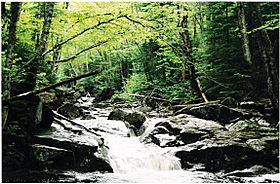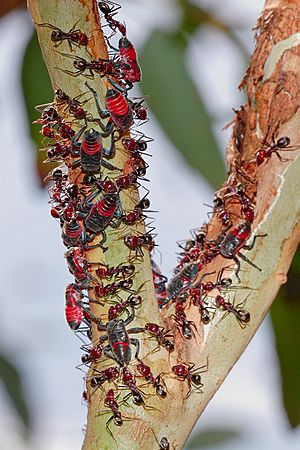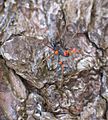Ecology facts for kids
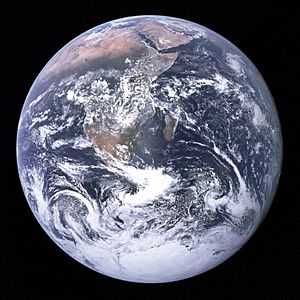 |
|
 |
|
|
Ecology is the science which studies the biota, the environment, and their interactions. It comes from the Greek oikos = house; logos = study.
Ecology is the study of ecosystems. Ecosystems describe the web or network of relations among organisms at different scales of organization. Since ecology refers to any form of biodiversity, ecologists research everything from tiny bacteria in nutrient recycling to the effects of tropical rain forests on the Earth's atmosphere. Scientists who study these interactions are called ecologists.
Terrestrial ecoregion and climate change research are two areas where ecologists now focus.
There are many practical applications of ecology in conservation biology, wetland management, natural resource management (agriculture, forestry, fisheries), city planning (urban ecology), community health, economics, and applied science. It provides a framework for understanding and researching human social interaction.
Contents
Levels, scope, and scale of organization
The scope of ecology contains a wide array of interacting levels of organization spanning micro-level (e.g., cells) to a planetary scale (e.g., biosphere) phenomena.
Biodiversity
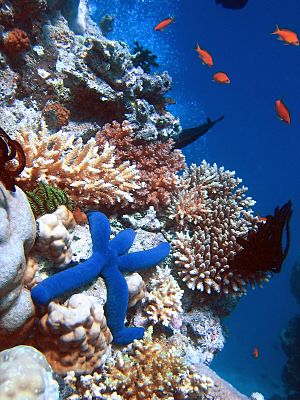
Biodiversity (an abbreviation of "biological diversity") describes the diversity of life from genes to ecosystems and spans every level of biological organization. The term has several interpretations, and there are many ways to index, measure, characterize, and represent its complex organization. Biodiversity includes species diversity, ecosystem diversity, and genetic diversity and scientists are interested in the way that this diversity affects the complex ecological processes operating at and among these respective levels. Biodiversity plays an important role in ecosystem services which by definition maintain and improve human quality of life. Preventing species extinctions is one way to preserve biodiversity and that goal rests on techniques that preserve genetic diversity, habitat and the ability for species to migrate. Conservation priorities and management techniques require different approaches and considerations to address the full ecological scope of biodiversity. Natural capital that supports populations is critical for maintaining ecosystem services and species migration (e.g., riverine fish runs and avian insect control) has been implicated as one mechanism by which those service losses are experienced. An understanding of biodiversity has practical applications for species and ecosystem-level conservation planners as they make management recommendations to consulting firms, governments, and industry.
Habitat
The habitat of a species describes the environment over which a species is known to occur and the type of community that is formed as a result. More specifically, "habitats can be defined as regions in environmental space that are composed of multiple dimensions, each representing a biotic or abiotic environmental variable; that is, any component or characteristic of the environment related directly (e.g. forage biomass and quality) or indirectly (e.g. elevation) to the use of a location by the animal." For example, a habitat might be an aquatic or terrestrial environment that can be further categorized as a montane or alpine ecosystem. Habitat shifts provide important evidence of competition in nature where one population changes relative to the habitats that most other individuals of the species occupy. For example, one population of a species of tropical lizards (Tropidurus hispidus) has a flattened body relative to the main populations that live in open savanna. The population that lives in an isolated rock outcrop hides in crevasses where its flattened body offers a selective advantage. Habitat shifts also occur in the developmental life history of amphibians, and in insects that transition from aquatic to terrestrial habitats. Biotope and habitat are sometimes used interchangeably, but the former applies to a community's environment, whereas the latter applies to a species' environment.
Additionally, some species are ecosystem engineers, altering the environment within a localized region. For instance, beavers manage water levels by building dams which improves their habitat in a landscape.
Niche
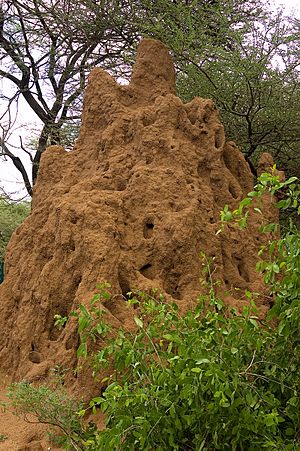
Species have functional traits that are uniquely adapted to the ecological niche. A trait is a measurable property, phenotype, or characteristic of an organism that may influence its survival. Genes play an important role in the interplay of development and environmental expression of traits. Resident species evolve traits that are fitted to the selection pressures of their local environment. This tends to afford them a competitive advantage and discourages similarly adapted species from having an overlapping geographic range. The competitive exclusion principle states that two species cannot coexist indefinitely by living off the same limiting resource; one will always out-compete the other.
Niche construction
Organisms are subject to environmental pressures, but they also modify their habitats. The regulatory feedback between organisms and their environment can affect conditions from local (e.g., a beaver pond) to global scales, over time and even after death, such as decaying logs or silica skeleton deposits from marine organisms. The process and concept of ecosystem engineering is related to niche construction, but the former relates only to the physical modifications of the habitat whereas the latter also considers the evolutionary implications of physical changes to the environment and the feedback this causes on the process of natural selection. Ecosystem engineers are defined as: "organisms that directly or indirectly modulate the availability of resources to other species, by causing physical state changes in biotic or abiotic materials. In so doing they modify, maintain and create habitats."
Biome
Biomes are larger units of organization that categorize regions of the Earth's ecosystems, mainly according to the structure and composition of vegetation. There are different methods to define the continental boundaries of biomes dominated by different functional types of vegetative communities that are limited in distribution by climate, precipitation, weather and other environmental variables. Biomes include tropical rainforest, temperate broadleaf and mixed forest, temperate deciduous forest, taiga, tundra, hot desert, and polar desert. Other researchers have recently categorized other biomes, such as the human and oceanic microbiomes. To a microbe, the human body is a habitat and a landscape. Microbiomes were discovered largely through advances in molecular genetics, which have revealed a hidden richness of microbial diversity on the planet. The oceanic microbiome plays a significant role in the ecological biogeochemistry of the planet's oceans.
Biosphere
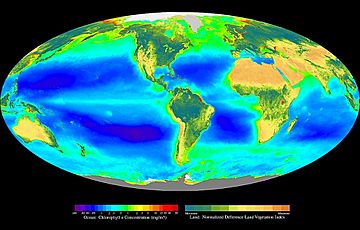
The largest scale of ecological organization is the biosphere: the total sum of ecosystems on the planet. Ecological relationships regulate the flux of energy, nutrients, and climate all the way up to the planetary scale. For example, the dynamic history of the planetary atmosphere's CO2 and O2 composition has been affected by the biogenic flux of gases coming from respiration and photosynthesis, with levels fluctuating over time in relation to the ecology and evolution of plants and animals. Ecological theory has also been used to explain self-emergent regulatory phenomena at the planetary scale: for example, the Gaia hypothesis is an example of holism applied in ecological theory. The Gaia hypothesis states that there is an emergent feedback loop generated by the metabolism of living organisms that maintains the core temperature of the Earth and atmospheric conditions within a narrow self-regulating range of tolerance.
Individual ecology
Understanding traits of individual organisms helps explain patterns and processes at other levels of organization including populations, communities, and ecosystems. Examples of such traits include features of an organisms life cycle such as age to maturity, life span, or metabolic costs of reproduction. Other traits may be related to structure, such as the spines of a cactus or dorsal spines of a bluegill sunfish, or behaviors such as courtship displays or pair bonding. Other traits include emergent properties that are the result at least in part of interactions with the surrounding environment such as growth rate, resource uptake rate, winter, and deciduous vs. drought deciduous trees and shrubs.
The traits of organisms are subject to change through acclimation, development, and evolution. For this reason, individuals form a shared focus for ecology and for evolutionary ecology.
Population ecology
Population ecology studies the dynamics of species populations and how these populations interact with the wider environment. A population consists of individuals of the same species that live, interact, and migrate through the same niche and habitat.
Metapopulations and migration
In metapopulation terminology, migrating individuals are classed as emigrants (when they leave a region) or immigrants (when they enter a region), and sites are classed either as sources or sinks. A site is a generic term that refers to places where ecologists sample populations, such as ponds or defined sampling areas in a forest. Source patches are productive sites that generate a seasonal supply of juveniles that migrate to other patch locations. Sink patches are unproductive sites that only receive migrants; the population at the site will disappear unless rescued by an adjacent source patch or environmental conditions become more favourable. Metapopulation models examine patch dynamics over time to answer potential questions about spatial and demographic ecology. The ecology of metapopulations is a dynamic process of extinction and colonization. Small patches of lower quality (i.e., sinks) are maintained or rescued by a seasonal influx of new immigrants. A dynamic metapopulation structure evolves from year to year, where some patches are sinks in dry years and are sources when conditions are more favourable. Ecologists use a mixture of computer models and field studies to explain metapopulation structure.
Community ecology
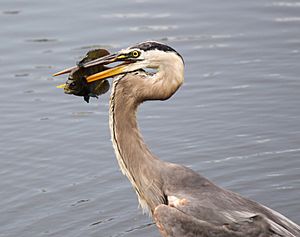
Community ecology is the study of the interactions among a collections of species that inhabit the same geographic area. Community ecologists study the determinants of patterns and processes for two or more interacting species. Research in community ecology might measure species diversity in grasslands in relation to soil fertility. It might also include the analysis of predator-prey dynamics, competition among similar plant species, or mutualistic interactions between crabs and corals.
Ecosystems may be habitats within biomes that form an integrated whole and a dynamically responsive system having both physical and biological complexes. Ecosystem ecology is the science of determining the fluxes of materials (e.g. carbon, phosphorus) between different pools (e.g., tree biomass, soil organic material). Ecosystem ecologist attempt to determine the underlying causes of these fluxes.
Food webs
A food web is the archetypal ecological network. Plants capture solar energy and use it to synthesize simple sugars during photosynthesis. As plants grow, they accumulate nutrients and are eaten by grazing herbivores, and the energy is transferred through a chain of organisms by consumption. The simplified linear feeding pathways that move from a basal trophic species to a top consumer is called the food chain. The larger interlocking pattern of food chains in an ecological community creates a complex food web. Food webs are a type of concept map or a heuristic device that is used to illustrate and study pathways of energy and material flows.

Food webs are often limited relative to the real world. Complete empirical measurements are generally restricted to a specific habitat, such as a cave or a pond, and principles gleaned from food web microcosm studies are extrapolated to larger systems. Feeding relations require extensive investigations into the gut contents of organisms, which can be difficult to decipher, or stable isotopes can be used to trace the flow of nutrient diets and energy through a food web. Despite these limitations, food webs remain a valuable tool in understanding community ecosystems.
Food webs exhibit principles of ecological emergence through the nature of trophic relationships: some species have many weak feeding links (e.g., omnivores) while some are more specialized with fewer stronger feeding links (e.g., primary predators). Theoretical and empirical studies identify non-random emergent patterns of few strong and many weak linkages that explain how ecological communities remain stable over time. Food webs are composed of subgroups where members in a community are linked by strong interactions, and the weak interactions occur between these subgroups. This increases food web stability. Step by step lines or relations are drawn until a web of life is illustrated.
Trophic levels
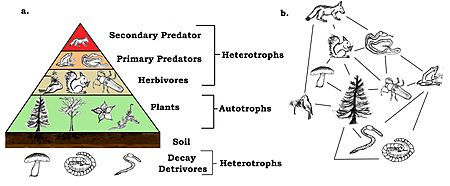
A trophic level is "a group of organisms acquiring a considerable majority of its energy from the adjacent level nearer the abiotic source." Links in food webs primarily connect feeding relations or trophism among species. Biodiversity within ecosystems can be organized into trophic pyramids, in which the vertical dimension represents feeding relations that become further removed from the base of the food chain up toward top predators, and the horizontal dimension represents the abundance or biomass at each level. When the relative abundance or biomass of each species is sorted into its respective trophic level, they naturally sort into a 'pyramid of numbers'.
Species are broadly categorized as autotrophs (or primary producers), heterotrophs (or consumers), and Detritivores (or decomposers). Autotrophs are organisms that produce their own food (production is greater than respiration) by photosynthesis or chemosynthesis. Heterotrophs are organisms that must feed on others for nourishment and energy (respiration exceeds production). Heterotrophs can be further sub-divided into different functional groups, including primary consumers (strict herbivores), secondary consumers (carnivorous predators that feed exclusively on herbivores), and tertiary consumers (predators that feed on a mix of herbivores and predators). Omnivores do not fit neatly into a functional category because they eat both plant and animal tissues. It has been suggested that omnivores have a greater functional influence as predators, because compared to herbivores, they are relatively inefficient at grazing.
Trophic levels are part of the holistic or complex systems view of ecosystems.
Keystone species
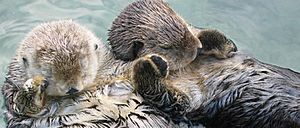
A keystone species is a species that is connected to a disproportionately large number of other species in the food-web.
Sea otters (Enhydra lutris) are commonly cited as an example of a keystone species; because, they limit the density of sea urchins that feed on kelp. If sea otters are removed from the system, the urchins graze until the kelp beds disappear, and this has a dramatic effect on community structure. Hunting of sea otters, for example, is thought to have led indirectly to the extinction of the Steller's sea cow (Hydrodamalis gigas). While the keystone species concept has been used extensively as a conservation tool, it has been criticized for being poorly defined from an operational stance. It is difficult to experimentally determine what species may hold a keystone role in each ecosystem. Furthermore, food web theory suggests that keystone species may not be common, so it is unclear how generally the keystone species model can be applied.
Behavioural ecology

Chameleons change their skin colour to match their background as a behavioural defence mechanism and also use colour to communicate with other members of their species, such as dominant (left) versus submissive (right) patterns shown in the three species (A-C) above.
All organisms can exhibit behaviours. Even plants express complex behaviour, including memory and communication. Behavioural ecology is the study of an organism's behaviour in its environment and its ecological and evolutionary implications. Ethology is the study of observable movement or behaviour in animals.
Adaptation is the central unifying concept in behavioural ecology. Behaviours can be recorded as traits and inherited in much the same way that eye and hair colour can. Behaviours can evolve by means of natural selection as adaptive traits conferring functional utilities that increases reproductive fitness.
Predator-prey interactions are an introductory concept into food-web studies as well as behavioural ecology. Prey species can exhibit different kinds of behavioural adaptations to predators, such as avoid, flee, or defend. Many prey species are faced with multiple predators that differ in the degree of danger posed. To be adapted to their environment and face predatory threats, organisms must balance their energy budgets as they invest in different aspects of their life history, such as growth, feeding, mating, socializing, or modifying their habitat.
(Iridomyrmex purpureus) in a symbiotic relationship. The ants protect the leafhoppers from predators and in return the leafhoppers feeding on plants exude honeydew from their anus that provides energy and nutrients to tending ants.
Related pages
Images for kids
-
Long-tailed broadbill building its nest
-
Bumblebees and the flowers they pollinate have coevolved so that both have become dependent on each other for survival.
-
The leaf is the primary site of photosynthesis in most plants.
-
The architecture of the inflorescence in grasses is subject to the physical pressures of wind and shaped by the forces of natural selection facilitating wind-pollination (anemophily).
-
The layout of the first ecological experiment, carried out in a grass garden at Woburn Abbey in 1816, was noted by Charles Darwin in The Origin of Species. The experiment studied the performance of different mixtures of species planted in different kinds of soils.
See also
 In Spanish: Ecología para niños
In Spanish: Ecología para niños


